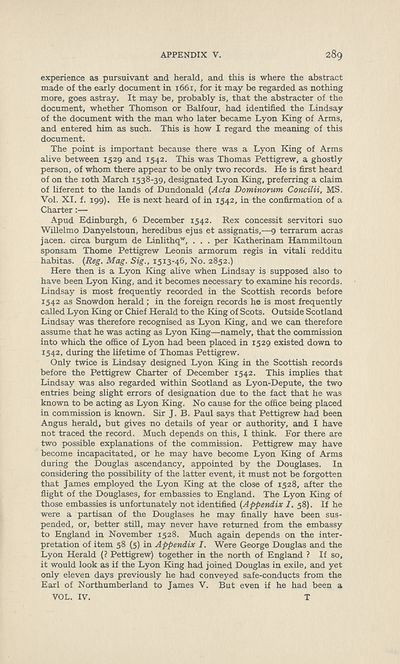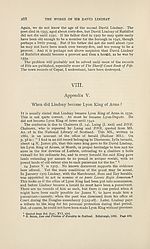Scottish Text Society publications > Third series > Works of Sir David Lindsay of the Mount, 1490-1555 > Volume 4, 1936
(357)
Download files
Complete book:
Individual page:
Thumbnail gallery: Grid view | List view

APPENDIX V.
289
experience as pursuivant and herald, and this is where the abstract
made of the early document in 1661, for it may be regarded as nothing
more, goes astray. It may be, probably is, that the abstracter of the
document, whether Thomson or Balfour, had identified the Lindsay
of the document with the man who later became Lyon King of Arms,
and entered him as such. This is how I regard the meaning of this
document.
The point is important because there was a Lyon King of Arms
alive between 1529 and 1542. This was Thomas Pettigrew, a ghostly
person, of whom there appear to be only two records. He is first heard
of on the xoth March 1538-39, designated Lyon King, preferring a claim
of liferent to the lands of Dundonald (Acta Dominorum Concilii, MS.
Vol. XI. f. 199). He is next heard of in 1542, in the confirmation of a
Charter :—
Apud Edinburgh, 6 December 1542. Rex concessit servitori suo
Willelmo Danyelstoun, heredibus ejus et assignatis,—9 terrarum acras
jacen. circa burgum de Linlithqw, . . . per Katherinam Hammiltoun
sponsam Thome Pettigrew Leonis armorum regis in vitali redditu
habitas. (Reg. Mag. Sig., 1513-46, No. 2852.)
Here then is a Lyon King alive when Lindsay is supposed also to
have been Lyon King, and it becomes necessary to examine his records.
Lindsay is most frequently recorded in the Scottish records before
1542 as Snowdon herald; in the foreign records he is most frequently
called Lyon King or Chief Herald to the King of Scots. Outside Scotland
Lindsay was therefore recognised as Lyon King, and we can therefore
assume that he was acting as Lyon King—namely, that the commission
into which the office of Lyon had been placed in 1529 existed down to
1542, during the lifetime of Thomas Pettigrew.
Only twice is Lindsay designed Lyon King in the Scottish records
before the Pettigrew Charter of December 1542. This implies that
Lindsay was also regarded within Scotland as Lyon-Depute, the two
entries being slight errors of designation due to the fact that he was
known to be acting as Lyon King. No cause for the office being placed
in commission is known. Sir J. B. Paul says that Pettigrew had been
Angus herald, but gives no details of year or authority, and I have
not traced the record. Much depends on this, I think. For there are
two possible explanations of the commission. Pettigrew may have
become incapacitated, or he may have become Lyon King of Arms
during the Douglas ascendancy, appointed by the Douglases. In
considering the possibility of the latter event, it must not be forgotten
that James employed the Lyon King at the close of 1528, after the
flight of the Douglases, for embassies to England. The Lyon King of
those embassies is unfortunately not identified (Appendix I. 58). If he
were a partisan of the Douglases he may finally have been sus¬
pended, or, better still, may never have returned from the embassy
to England in November 1528. Much again depends on the inter¬
pretation of item 58 (5) in Appendix I. Were George Douglas and the
Lyon Herald (? Pettigrew) together in the north of England ? If so,
it would look as if the Lyon King had joined Douglas in exile, and yet
only eleven days previously he had conveyed safe-conducts from the
Earl of Northumberland to James V. But even if he had been a
VOL. IV. T
289
experience as pursuivant and herald, and this is where the abstract
made of the early document in 1661, for it may be regarded as nothing
more, goes astray. It may be, probably is, that the abstracter of the
document, whether Thomson or Balfour, had identified the Lindsay
of the document with the man who later became Lyon King of Arms,
and entered him as such. This is how I regard the meaning of this
document.
The point is important because there was a Lyon King of Arms
alive between 1529 and 1542. This was Thomas Pettigrew, a ghostly
person, of whom there appear to be only two records. He is first heard
of on the xoth March 1538-39, designated Lyon King, preferring a claim
of liferent to the lands of Dundonald (Acta Dominorum Concilii, MS.
Vol. XI. f. 199). He is next heard of in 1542, in the confirmation of a
Charter :—
Apud Edinburgh, 6 December 1542. Rex concessit servitori suo
Willelmo Danyelstoun, heredibus ejus et assignatis,—9 terrarum acras
jacen. circa burgum de Linlithqw, . . . per Katherinam Hammiltoun
sponsam Thome Pettigrew Leonis armorum regis in vitali redditu
habitas. (Reg. Mag. Sig., 1513-46, No. 2852.)
Here then is a Lyon King alive when Lindsay is supposed also to
have been Lyon King, and it becomes necessary to examine his records.
Lindsay is most frequently recorded in the Scottish records before
1542 as Snowdon herald; in the foreign records he is most frequently
called Lyon King or Chief Herald to the King of Scots. Outside Scotland
Lindsay was therefore recognised as Lyon King, and we can therefore
assume that he was acting as Lyon King—namely, that the commission
into which the office of Lyon had been placed in 1529 existed down to
1542, during the lifetime of Thomas Pettigrew.
Only twice is Lindsay designed Lyon King in the Scottish records
before the Pettigrew Charter of December 1542. This implies that
Lindsay was also regarded within Scotland as Lyon-Depute, the two
entries being slight errors of designation due to the fact that he was
known to be acting as Lyon King. No cause for the office being placed
in commission is known. Sir J. B. Paul says that Pettigrew had been
Angus herald, but gives no details of year or authority, and I have
not traced the record. Much depends on this, I think. For there are
two possible explanations of the commission. Pettigrew may have
become incapacitated, or he may have become Lyon King of Arms
during the Douglas ascendancy, appointed by the Douglases. In
considering the possibility of the latter event, it must not be forgotten
that James employed the Lyon King at the close of 1528, after the
flight of the Douglases, for embassies to England. The Lyon King of
those embassies is unfortunately not identified (Appendix I. 58). If he
were a partisan of the Douglases he may finally have been sus¬
pended, or, better still, may never have returned from the embassy
to England in November 1528. Much again depends on the inter¬
pretation of item 58 (5) in Appendix I. Were George Douglas and the
Lyon Herald (? Pettigrew) together in the north of England ? If so,
it would look as if the Lyon King had joined Douglas in exile, and yet
only eleven days previously he had conveyed safe-conducts from the
Earl of Northumberland to James V. But even if he had been a
VOL. IV. T
Set display mode to: Large image | Zoom image | Transcription
Images and transcriptions on this page, including medium image downloads, may be used under the Creative Commons Attribution 4.0 International Licence unless otherwise stated. ![]()
| Publications by Scottish clubs > Scottish Text Society publications > Third series > Works of Sir David Lindsay of the Mount, 1490-1555 > Volume 4, 1936 > (357) |
|---|
| Permanent URL | https://digital.nls.uk/107279159 |
|---|
| Shelfmark | SCS.STES3.8 |
|---|---|
| Attribution and copyright: |
|
| Description | A collection of over 100 Scottish texts dating from around 1400 to 1700. Most titles are in Scots, and include editions of poetry, drama, and prose by major Scottish writers such as John Barbour, William Dunbar, Gavin Douglas, and George Buchanan. Edited by a key scholarly publisher of Scotland's literary history, and published from the late 19th century onwards by the Scottish Text Society. Available here are STS series 1-3. |
|---|

